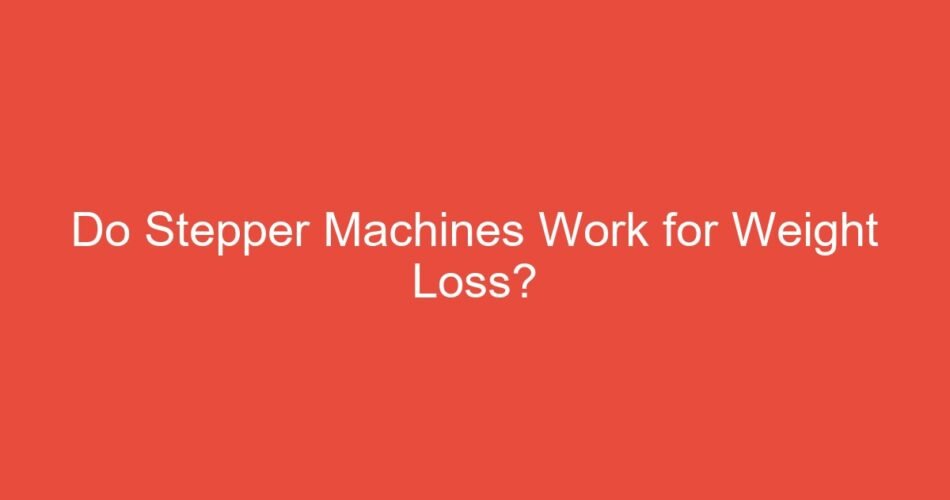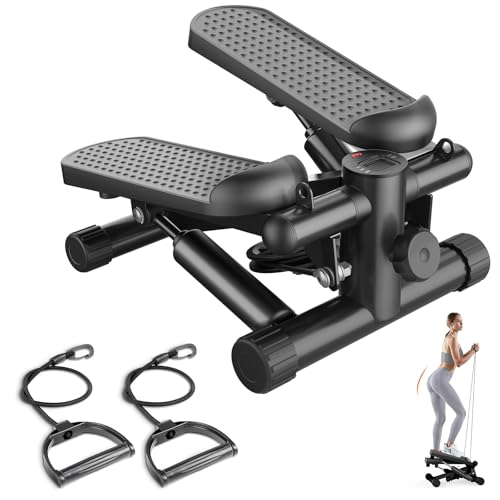Want to know Do Stepper Machines Work for Weight Loss? The quick answer is absolutely yes they are one of the most effective tools for burning fat and building muscle simultaneously.
Do Stepper Machines Work for Weight Loss they are highly effective and are considered a gold standard machine for high-intensity cardiovascular exercise. Steppers, also known as stair climbers, combine intense cardio with crucial resistance training, maximizing the number of calories burned in a short period. This dual-action mechanism makes the stepper an efficient choice for anyone focused on creating a significant calorie deficit necessary for shedding pounds.
The Calorie Burn Equation
Weight loss fundamentally relies on achieving a consistent calorie deficit: burning more energy than you consume. Stepper machines excel at accelerating this process because they force the user to work against gravity and body weight, resulting in exceptionally high energy expenditure.
🛒 Recommended Product
Steppers offer one of the highest calorie burns per hour of any standard cardio machine.
Depending on the user’s weight, intensity, and duration, the average person can expect to burn between 500 and 800 calories per hour on a stepper. This rate often surpasses that of treadmills (running flat) or elliptical trainers, particularly because the motion of climbing stairs engages large muscle groups in the lower body simultaneously. This high output is essential for quick, measurable results when trying to reduce overall body fat.
To put this into context, consider the energy required to burn one pound of body fat, which is roughly 3,500 calories. By using a stair climber consistently for 30 minutes, five days a week, a user burning 350-400 calories per session could shed a pound of fat every two weeks simply by incorporating the exercise, without any dietary changes. When combined with smart nutrition, the results accelerate rapidly.
Why Steppers Outpace Flat Cardio
The resistance inherent in the stepping motion is what differentiates it from simply walking or jogging on a flat surface. Every step is a mini-lunge against gravity, demanding maximum effort from the major locomotor muscles.
- Continuous Muscle Activation: Unlike cycling or elliptical use where momentum can take over, the stair climber requires continuous, deliberate force to push the pedals down. This sustained muscular effort keeps the heart rate elevated in the fat-burning zone (typically 70–85% of Maximum Heart Rate).
- High-Intensity Interval Training (HIIT): Steppers are perfectly suited for HIIT protocols. Alternating between short, explosive bursts (maximum climbing speed) and brief recovery periods significantly boosts Excess Post-exercise Oxygen Consumption (EPOC), leading to the “afterburn effect.” This means your body continues to burn calories at an elevated rate for hours after your workout is complete, which is a key component of effective fat burning.
Beyond Cardio The Resistance Factor
While many people focus purely on the cardiovascular benefits of stair climbing, the hidden secret to its effectiveness for sustained weight loss lies in its ability to build and strengthen muscle—a form of functional resistance training. Building lean muscle mass is vital because muscle is metabolically active, meaning it requires more calories to maintain than fat tissue, even while you are at rest.
The primary muscle groups intensely engaged during a stepper machine workout include:
| Muscle Group | Function During Stepping | Weight Loss Benefit |
|---|---|---|
| Gluteus Maximus | Propels the body upward (primary power source) | Tones the largest muscle group, increasing calorie demand |
| Hamstrings | Assists glutes in hip extension and knee flexion | Increases metabolic rate due to large muscle involvement |
| Quadriceps | Straightens the knee during the push-off phase | Supports joint stability and adds high-intensity workload |
| Calves (Gastrocnemius) | Assists in ankle extension and heel lift | Improves endurance and overall lower-body power |
| Core & Erectors | Stabilizes the torso, preventing swaying | Improves posture and prevents energy leakage |
Because the stepping motion mimics real-world movements (climbing stairs or hills), it builds functional strength. This increase in muscle mass ensures that the weight loss achieved is sustainable. When your body has more muscle, your basal metabolic rate (BMR) rises, making it easier to maintain a calorie deficit and prevent weight regain in the future.
🛒 Recommended Product
Maximizing Weight Loss Results
To optimize the potential of your stair climber for achieving rapid and lasting weight loss goals, specific training strategies must be employed. A machine that delivers high-intensity results requires a high-intensity approach.
1. Integrate High-Intensity Interval Training (HIIT)
Standard steady-state cardio, while beneficial, eventually leads to plateaus. HIIT shocks the system, forcing your body to adapt and burn more energy.
- The 20/40 Protocol: After a 5-minute warm-up, step hard at an almost unsustainable pace for 20 seconds. Immediately drop to a slow, recovery pace for 40 seconds. Repeat this cycle 10 to 15 times before cooling down. This structure significantly leverages the afterburn effect, dramatically increasing overall calorie burn.
2. Focus on Form and Intensity
A common mistake is leaning heavily on the railings. Relying on the handrails reduces the necessary effort and transfers workload away from the target muscles (glutes and hamstrings) and onto the arms, decreasing the effectiveness of the high-intensity workout.
- Maintain Upright Posture: Keep your back straight, chest lifted, and only lightly touch the railings for balance.
- Deep Step Engagement: Focus on pushing through your heels to activate the powerful glute muscles. This ensures you are utilizing the resistance factor to its fullest.
3. Consistency and Frequency
For significant weight loss, the American College of Sports Medicine (ACSM) recommends at least 150–300 minutes of moderate-intensity exercise per week. Because the stepper is a vigorous activity, you can achieve weight loss goals efficiently with slightly less time if the intensity remains high. Aim for three to five 30-minute sessions per week.
4. The Calorie Deficit is King
While the stair climber helps accelerate energy expenditure, successful long-term weight loss always requires dietary awareness. Even the most intense stepper workout cannot counteract a diet high in excess calories.
| Weight Loss Component | Stepper’s Contribution | Importance |
|---|---|---|
| Calorie Deficit | High-volume calorie expenditure | Essential |
| Metabolic Increase | Builds muscle mass and raises BMR | Crucial for sustainability |
| Cardiovascular Health | Improves heart and lung function | General wellness benefit |
| Joint Health | Low impact compared to running | Reduces risk of injury |
The stepper machine is a powerful tool, but it works best when combined with clean eating to ensure that the intense effort put into the exercise translates into fat reduction.
🛒 Recommended Product
Conclusion
Do Stepper Machines Work for Weight Loss? The definitive answer is yes, due to their unparalleled ability to combine intense cardiovascular activity with powerful resistance training. By creating a substantial calorie deficit and building metabolically active muscle mass, the stair climber is one of the fastest and most efficient machines available for achieving significant weight loss and improving overall fitness.
Scientific References & Research
The following peer-reviewed research papers provide additional scientific context:
-
AJ Bianculli (2009).
Stepper motors: application and selection
[External Link] -
VV Athani (1997).
[B] Stepper motors: fundamentals, applications and design
[External Link] -
MО Реуцький et al. (2021).
SELECTION AND CALCULATION OF STEPPER MOTORS FOR CNC
[External Link]
Note: External research links are provided for educational purposes and do not necessarily represent endorsement.
Frequently Asked Questions About Do Stepper Machines Work for Weight Loss?
Q. Is the ‘afterburn effect’ (EPOC) a significant benefit of using a stepper machine for fat loss?
A. Yes, particularly if you incorporate high-intensity interval training (HIIT) into your stepper routine. HIIT sessions performed on a stepper dramatically increase excess post-exercise oxygen consumption (EPOC), meaning your body continues to burn calories at an elevated rate even after you finish the workout. This prolonged metabolic boost makes the stepper an excellent tool for maximizing fat loss efficiency.
Q. Beyond just burning calories, what role does muscle building from a stepper play in overall weight management?
A. Stepper machines effectively build and tone the major muscles of the lower body, including the glutes, hamstrings, and quads. Increasing muscle mass is crucial for long-term weight management because muscle tissue is metabolically more active than fat tissue, boosting your resting metabolic rate (RMR). A higher RMR means you burn more calories throughout the day, even when sedentary.
Q. How important is the resistance level and step height on the machine when optimizing a workout specifically for weight loss?
A. Adjusting the resistance and step height is crucial as it dictates the intensity and the amount of muscular effort required. Higher resistance and step height increase the challenge, leading to greater muscle engagement and a substantially higher cardiovascular demand. This increased intensity directly translates to more calories burned in a shorter timeframe, accelerating weight loss progress.
Qt. Are stepper machines better for fat loss than low-impact cardio activities like walking?
A. Generally, yes; while walking is beneficial, the stepper machine offers a more intense, higher-impact cardio and strength workout. The continuous upward resistance and required balance elevate the heart rate significantly higher and activate more muscle fibers than standard walking, leading to a much greater caloric burn per minute and superior results for fat loss.
Q. What are common mistakes people make when using a stepper machine that can hinder their weight loss efforts?
A. A common mistake is leaning heavily on the handles, which reduces the effective resistance and minimizes the workload on the legs and core. Another error is maintaining a slow, easy pace throughout the entire workout, failing to push the heart rate into the optimal fat-burning zones. To maximize weight loss, users should maintain an upright posture and vary their intensity through interval training.
Related Articles
What Is the Best Workout Machine for Weight Loss?
Trying to determine what is the best workout machine for weight loss? While several options deliver results, the rowing machine often provides the max…
Do Vibrating Weight Loss Machines Work?
Do vibrating weight loss machines work? The scientific data is clear: while these vibration therapy plates offer proven benefits like muscle stimulati…
Treadmill Workouts for Buttocks: Sculpt and Tone Your Glutes
Getting fit and shaping your buttocks can be challenging. Treadmill workouts might be the solution you need. Treadmill workouts are not just for cardi…
When you purchase a product through Amazon links on EllipticalKing.com, we may earn a small commission at no extra cost to you. This helps support the site and keep our content free.




